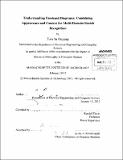| dc.contributor.advisor | Randall Davis. | en_US |
| dc.contributor.author | Ouyang, Tom Yu | en_US |
| dc.contributor.other | Massachusetts Institute of Technology. Dept. of Electrical Engineering and Computer Science. | en_US |
| dc.date.accessioned | 2012-07-02T15:47:16Z | |
| dc.date.available | 2012-07-02T15:47:16Z | |
| dc.date.copyright | 2012 | en_US |
| dc.date.issued | 2012 | en_US |
| dc.identifier.uri | http://hdl.handle.net/1721.1/71487 | |
| dc.description | Thesis (Ph. D.)--Massachusetts Institute of Technology, Dept. of Electrical Engineering and Computer Science, 2012. | en_US |
| dc.description | Cataloged from PDF version of thesis. | en_US |
| dc.description | Includes bibliographical references (p. 99-102). | en_US |
| dc.description.abstract | As our interaction with computing shifts away from the traditional desktop model (e.g., towards smartphones, tablets, touch-enabled displays), the technology that drives this interaction needs to evolve as well. Wouldn't it be great if we could talk, write, and draw to a computer just like we do with each other? This thesis addresses the drawing aspect of that vision: enabling computers to understand the meaning and semantics of free-hand diagrams. We present a novel framework for sketch recognition that seamlessly combines a rich representation of local visual appearance with a probabilistic graphical model for capturing higher level relationships. This joint model makes our system less sensitive to noise and drawing variations, improving accuracy and robustness. The result is a recognizer that is better able to handle the wide range of drawing styles found in messy freehand sketches. To preserve the fluid process of sketching on paper, our interface allows users to draw diagrams just as they would on paper, using the same notations and conventions. For the isolated symbol recognition task our method exceeds state-of-the-art performance in three domains: handwritten digits, PowerPoint shapes, and electrical circuit symbols. For the complete diagram recognition task it was able to achieve excellent performance on both chemistry and circuit diagrams, improving on the best previous results. Furthermore, in an on-line study our new interface was on average over twice as fast as the existing CAD-based method for authoring chemical diagrams, even for novice users who had little or no experience using a tablet. This is one of the first direct comparisons that shows a sketch recognition interface significantly outperforming a professional industry-standard CAD-based tool. | en_US |
| dc.description.statementofresponsibility | by Tom Yu Ouyang. | en_US |
| dc.format.extent | 102 p. | en_US |
| dc.language.iso | eng | en_US |
| dc.publisher | Massachusetts Institute of Technology | en_US |
| dc.rights | M.I.T. theses are protected by
copyright. They may be viewed from this source for any purpose, but
reproduction or distribution in any format is prohibited without written
permission. See provided URL for inquiries about permission. | en_US |
| dc.rights.uri | http://dspace.mit.edu/handle/1721.1/7582 | en_US |
| dc.subject | Electrical Engineering and Computer Science. | en_US |
| dc.title | Understanding freehand diagrams : combining appearance and context for multi-domain sketch recognition | en_US |
| dc.title.alternative | Combining appearance and context for multi-domain sketch recognition | en_US |
| dc.type | Thesis | en_US |
| dc.description.degree | Ph.D. | en_US |
| dc.contributor.department | Massachusetts Institute of Technology. Department of Electrical Engineering and Computer Science | |
| dc.identifier.oclc | 795577020 | en_US |
